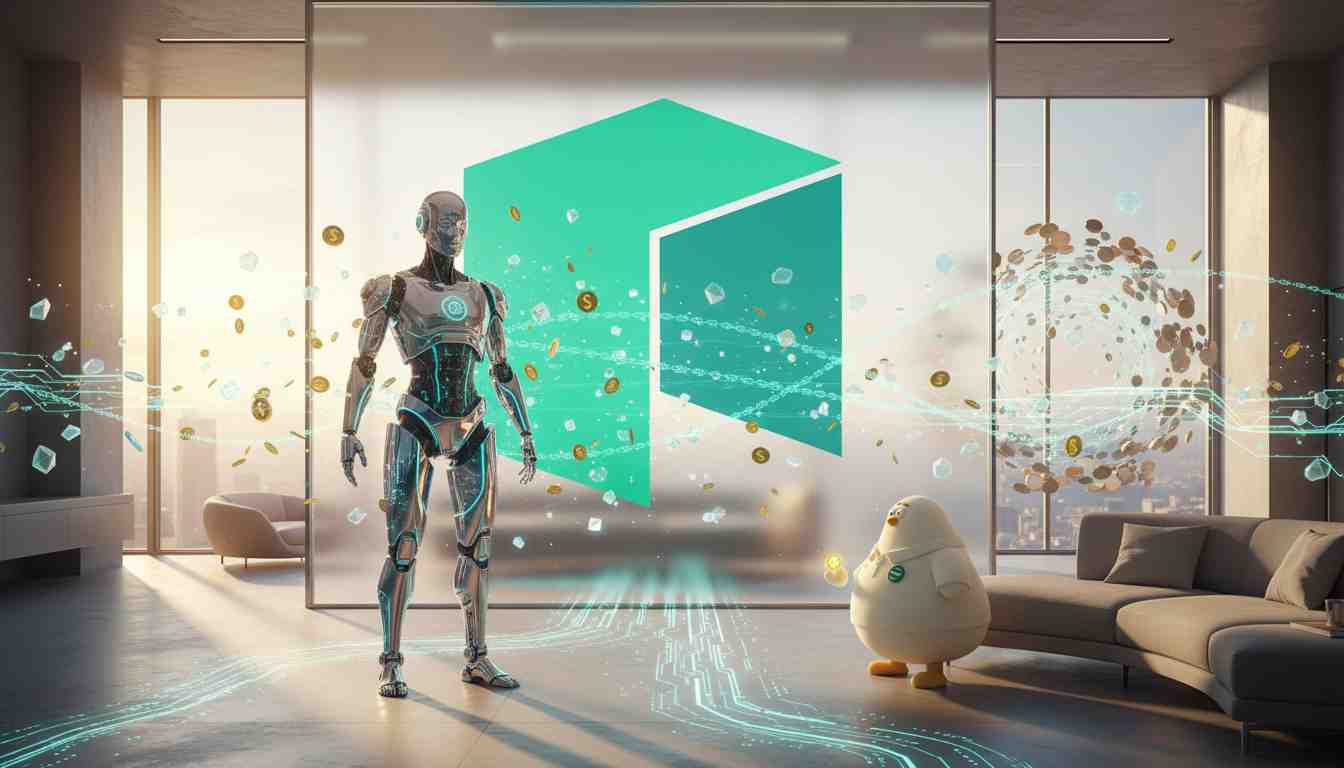V3 Research
Web3 Opportunities related to the NEO robot
NeoAIToken
The website introduces $NEO as an Ethereum-based meme and utility token designed to integrate with the Neo humanoid robot, enabling payments, tipping, and ecosystem interaction.
Medium
The article discusses how blockchain’s transparency and smart contracts can coordinate tasks, data sharing, and payments in collaborative robotics scenarios.
Onchain.org
This piece argues that Web3 infrastructure is critical for scaling humanoid robots, enabling decentralized collaboration and new business models.
Gate Learn
The report outlines how Web3 technologies provide verifiable, privacy-preserving coordination among distributed robotic networks.

Executive Summary
The convergence of 1X Technologies’ NEO humanoid robot with blockchain creates a nascent “machine economy” where tokens, smart contracts, and decentralized data markets can fund, coordinate, and govern fleets of household robots 14820. Early pilots—from the $NEO utility-meme token to Series B fund-raising and Web3Labs accelerator grants—indicate multiple entry points for investors, developers, and service providers across the Web3 stack 101236.
Key Numeric Indicators
| Item | Figure | Context | Sources |
|---|---|---|---|
| Retail price of NEO robot | ≈ $20,000 | Initial preorder cost for home units | 20 |
| Series B capital raised | $100 million | Fuels second-gen NEO development | 10 |
| Planned new funding | Up to $1 billion at $10 billion valuation | Accelerate large-scale rollout | 36 |
| Humanoid robot market CAGR | From $2.03 B (2024) to $13.25 B (2029) | Rapid sector expansion | 21 |
| $NEO memecoin peak surge | +5,100 % | Illustrates speculative token demand | 8 |
Tokenization & Machine Economy
Web3 allows each robot—or swarm of robots—to act as an autonomous economic agent. The Ethereum-based $NEO token positions itself as a payment, tipping, and potential governance asset for services rendered by NEO units 18. Similar concepts are outlined in broader robotics-blockchain surveys that envision robots selling data or micro-tasks for crypto, eliminating intermediaries and enabling new revenue streams for owners 3233. By linking on-chain wallets to robot IDs, tasks such as cleaning or delivery can trigger instant micropayments, while on-chain histories provide auditable service records that increase trust in shared or rental models 2930.
Decentralized Coordination & Data Sharing
Humanoid robots require continuous learning and coordinated updates. Research on blockchain-empowered multi-robot collaboration shows how distributed ledgers can synchronize task allocation, firmware updates, and sensor data without centralized servers 2930. Smart-contract frameworks described in human-robot collaboration studies further illustrate permissioned data feeds where privacy-sensitive household footage is encrypted yet verifiably exchanged for training rewards 231. For 1X, integrating such protocols could lower cloud costs and speed reinforcement learning across thousands of units while giving owners control over what data is monetized 442.
Investment & Funding Dynamics
Institutional appetite is escalating: 1X closed a $100 million Series B in 2024, then signaled a $1 billion raise at a $10 billion valuation to finance consumer rollout and factory tooling 103637. Simultaneously, Web3-native capital is forming around accelerators; Neo’s $1 million Web3Labs program subsidizes startups building on its stack 12. Token speculation remains volatile—$NEO’s 5,100 % spike drew headlines yet underscores liquidity risk absent real robot integration 820. Strategic investors can diversify across equity, protocol tokens, and data-sharing marketplaces as the hardware matures.
Governance, Incentives & Community Building
Robotics protocols benefit from on-chain voting to steer software updates, safety parameters, and revenue distribution. Governance reform discussions in the Neo blockchain community highlight how quadratic voting and delegated staking can align diverse stakeholders, from robot owners to AI developers 43. Staking mechanisms proposed by companion projects also create recurring yields that can offset robot maintenance fees while securing off-chain compute bridges 515. Community hackathons and token-gated forums foster open-source tooling, accelerating feature rollouts such as task-specific skill NFTs that users can purchase and sideload onto their robots 2241.
Risks, Challenges & Adoption Roadmap
Hardware reliability, privacy, and security dominate critiques: early reviews note partial tele-operation, narrow task sets, and potential household surveillance concerns 172439. Blockchain can mitigate some threats via tamper-proof logs and zero-knowledge-based access controls, yet high gas fees and UX friction remain barriers to mainstream families 2033. Analysts project that meaningful household penetration will not occur until 2026-2027, after cost curves decline and regulatory frameworks clarify liability for autonomous actions 192635. In the interim, pilot programs in corporate facilities and token-incentivized data-collection campaigns will serve as stepping-stones.
Further Exploration
- Model token-based revenue splits between robot owners, manufacturers, and AI developers.
- Design privacy-preserving data marketplaces using zero-knowledge proofs for household sensor feeds.
- Assess rollup vs sidechain architectures for low-cost micro-transactions between robots.
- Map regulatory pathways for securitized robot-leasing tokens across jurisdictions.
- Track KPI dashboards combining on-chain activity with unit shipment statistics to gauge adoption.
Would you like a deeper dive into how token-gated skill NFTs could monetize NEO’s app ecosystem?
(Visit Discover for more)
1 days ago